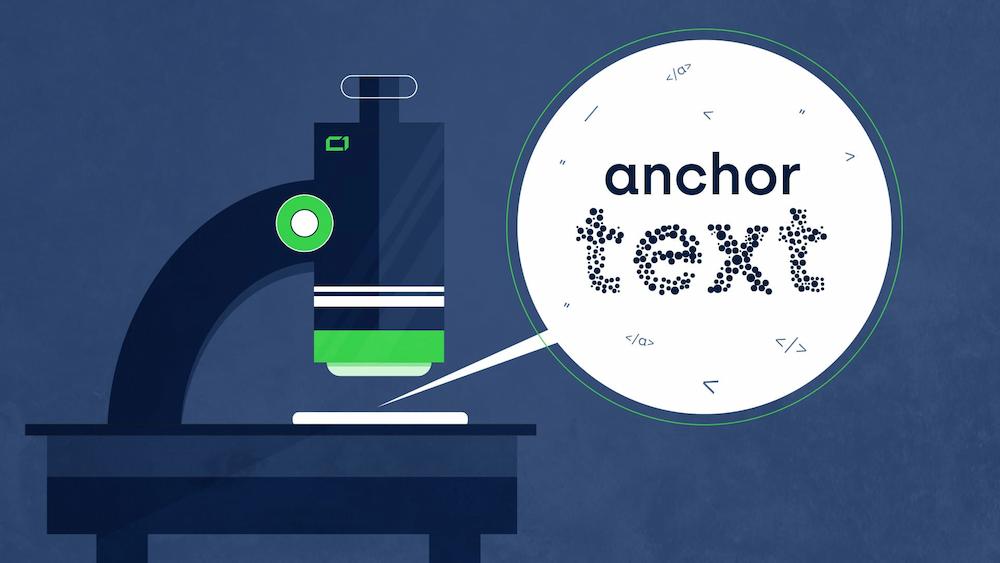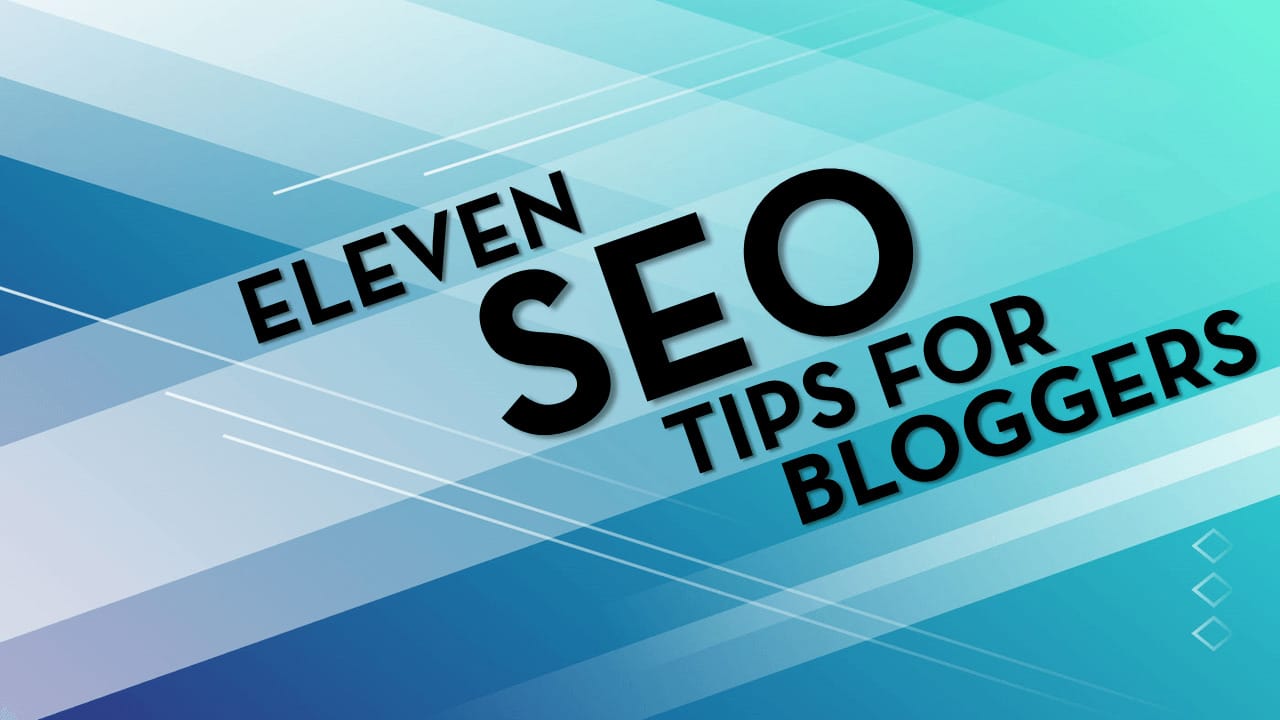Anchor text is the clickable text in a hyperlink. It serves to provide users with additional information about what they can find on a linked website, usually via the target keyword used in the anchor. Anchor text is one of the key elements of the web, perhaps even its most recognizable feature. It allows for a seamless reference to an external source, improving the user experience and increasing the range of possibilities of expression for content creators. They’re often used to describe the linked page, like “JavaScript SEO Services,” but they don’t always do that. Sometimes they just give a generic description such as “click here” or “read more”.
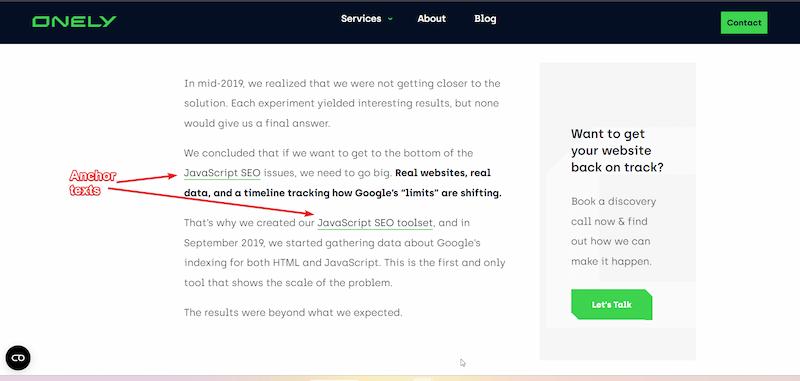
Back in the day, there used to be mainly bare URL addresses. However, it’s usually not enough for users to deduce the type of content they can expect when they click. Nowadays, imagining any linking with no anchor text feature is difficult.
Why is anchor text important?
The answer is simple: anchor texts help Google and users better understand what the linked page is about.
In 1998, Google cofounders Sergey Brin and LarryPage published a paper describing what the Google algorithm is based on, and next to page rank and proximity, one of these elements was the anchor text.
The authors wrote about the importance of the anchor text that appears next to each link. They noted that the anchor text often serves as a hint for Google to better understand what the page is about. Besides this, anchor texts can often provide more accurate description of a website than its content. The same works for users – a good anchor text is informative and can enhance your page’s user experience.
That makes anchor texts a very powerful SEO tool.
There’s also one thing – when anchor texts are relevant (they properly match the page’s content and linked pages provide more information on the topic), then Google better understands the site structure. It better sees how pages are related to each other. So it’s quite reasonable to use keywords here.
What’s more, every time you link pages to each other, you create new paths for Google to discover those pages. The more relevant paths are there, the quicker Google might crawl your page (provided that no other elements prevent it).
Types of anchor text and their influence on SEO
There are multiple anchor text variations that you can use to link to a webpage. They are classified in terms of their relation to the target keyword, for which the destination website is optimized. You can adjust your anchor text profile through combining URL anchors, keywords and your brand name.
Exact-match anchors
Exact-match anchor text is the most straightforward type of anchors and it’s often used in internal links. It consists of the keyword which exactly reflects the content of the website that it’s linking to.
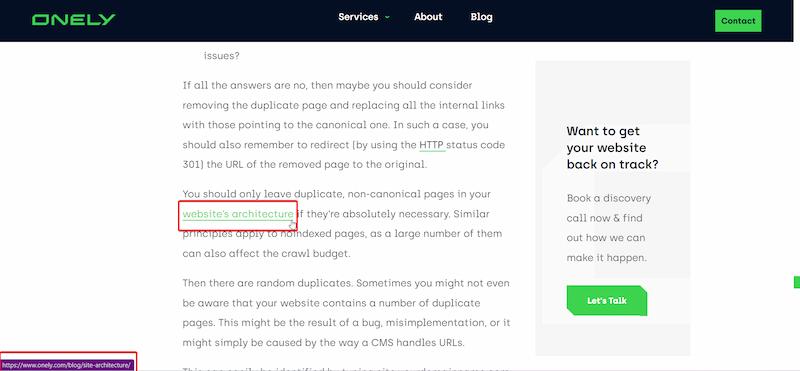
For example: if I wanted to link to Onely’s article “The Ultimate Guide to Crawl Budget”, then my exact anchor text could be “crawl budget”.
Partial-match anchors
Partial-match anchor text is somewhat similar to the exact-match anchor text, however it consists of only the part of the keyword OR the keyword and also other words, which makes it more descriptive. For example: “Tips on how to optimize the crawl budget“. Page’s title tag can serve as a partial-match anchor text.
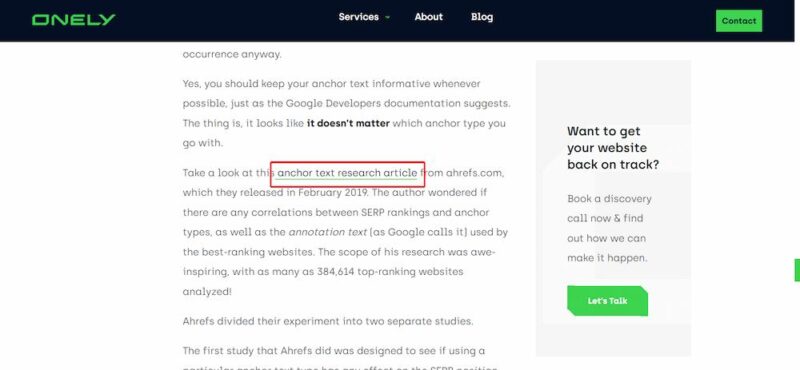
This kind of anchor text looks very natural, because it’s often used by non-SEO users. This type of anchor is also commonly used in internal links.
Generic anchors (a.k.a. zero-match anchor)
This kind of anchor link does not consist of any keyword. Usually, generic anchor text encourages users to a specific action or indicates exactly where users should click. “Click here”, “read more” or “here” are the most common examples of generic anchor texts. They’re often used on buttons with CTAs.
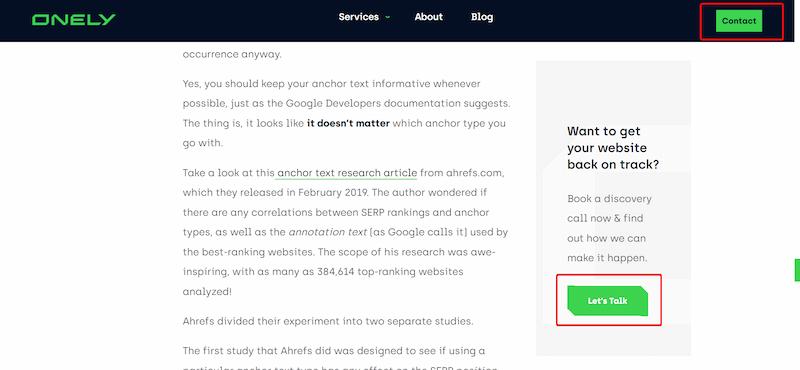
One could say that zero-match anchors do not have any specific value from the SEO perspective, since they don’t include any target keyword or provide no additional information. However, sometimes they’re the right choice (if it feels natural to use them in some context), especially if you want to balance-out the ratio of keyword anchor texts with more neutral messages (we don’t want any keyword stuffing here!)
Naked link anchors (or URL anchors)
A naked link contains the URL of the page or its fragments as an anchor text. Naked anchor links on the one hand still provide link equity from the referring page, but on the other hand they do not add any context between the keyword and the linked page. Also, from a purely UX point of view, I would avoid using URL anchors in the text (e.g. instead of exact-match or partial-match anchor links) as they are less readable than a regular keyword. These types of links can be found most often in bibliographies or linked sources of information in documents such as white-papers.
Branded anchors
The branded text contains the name of the brand. So, for example, if I wanted to use branded text to link to Onely’s website, I could use : SEO Services by Onely.
Image anchors
Images are also used as anchor links. In that case, the anchor text is the image’s alt attribute.
It is worth noting that text links pass more link juice than image links. However, Google always emphasizes that “make pages primarily for users, not for search engines”, so if in a given case placing a link under the image is more natural and user-friendly than a text link, then choose this option. Image anchor links are most often found in e-commerce – when you’re scrolling the category, it’s far more convenient to tap on a big image than on a much smaller text link.
We also prepared a handy infographic that gathers anchor text types in a nutshell:

Is the surrounding text a factor?
In the past, Google has considered using the text surrounding a link for rating the resource’s relevance. Their “Ranking based on reference contexts” patent, filed in 2004, describes a system which “analyzes a portion of the first document associated with the reference, identifies a rare word (or words) from the portion, creates a context identifier based on the rare word(s), and ranks the second document based on the context identifier.”
To simplify, Google was tinkering with a system that would recognize what a link placed in a text file is pointing to, based on the text surrounding that link.
However, Google never addressed whether or not their algorithm is, in fact, using surrounding text to evaluate links. And testing it is more and more difficult as the search engine is getting better at assessing the entirety of a page’s content.
Because of that, the only piece of advice that we can refer to is what can be found in the Google documentation: use anchor text that directly corresponds to what the linked page is about.
How to optimize anchor text?
In terms of SEO, optimizing anchor text has been one of the basics since the early days of the internet. Under- as well as over-optimised anchor texts don’t do good neither for SEOs nor for users. As it often is, SEOs have to refer to Google documentation for guidance. Their article on link text gives some essential advice on what a suitable anchor text should be.
Tips for SEO-friendly anchor text
Before we head to the anchor text optimization, let’s start with basics. A good anchor text is:
- descriptive (text used in anchor should give a basic idea of what the linked page linked is about)
- concise (usually includes a few words or a keyword)
- easy to spot (anchor link should stand out against the rest of the text that is not linked).
Google also notices that in your pay more attention to anchors for internal links than for external anchors. For more details on each of these points see Google’s Starter Guide.
Now, in your anchor text strategy you need to pay attention to more details. Google really puts emphasize on making things seamless, neat and intuitive. That’s why it’s worth to remember to:
- keep your anchors relevant to the content you’re linking to
- don’t overdo with keyword-rich anchors (don’t try to put keywords in every anchor – use them only if that makes sense. Keep anchors natural and user-friendly).
- use as little generic anchors as possible
For more tips on anchor text optimization see Google’s guide on Link text.
Which anchor text type should you use?
In the past, many gray- or black-hat SEO strategies were used with anchor text, and they boasted significant results.
Nowadays, the SEO community is full of contradictory opinions on the efficiency of one type of anchor text over the other. People who want to play by the rules avoid over-optimizing anchor text. Meanwhile, some SEOs suggest using percentage-based systems of implementing anchor text types which are supposed to grant a significant ranking boost.
As a website owner, you don’t usually have complete control over the anchor text used for backlinks to your domain anyway. One exception to this is when you are guest-posting, which is a rare occurrence anyway.
Yes, you should keep your anchor text informative whenever possible, just as the Google Developers documentation suggests. The thing is, it looks like it doesn’t matter which anchor type you go with.
Take a look at this anchor text research article from ahrefs.com, which they released in February 2019. The author wondered if there are any correlations between SERP rankings and anchor types, as well as the annotation text (as Google calls it) used by the best-ranking websites. The scope of his research was awe-inspiring, with as many as 384,614 top-ranking websites analyzed!
Ahrefs divided their experiment into two separate studies.
The first study that Ahrefs did was designed to see if using a particular anchor text type has any effect on the SERP position. They found that the correlation was very weak and, in some cases, effectively non-existent!
The second one looked into the influence of surrounding link text on the search results. Their findings? There is effectively no correlation with the search results position for any type of keyword in the surrounding link text.
The other point (and Ahrefs mentions it too) is that it is virtually impossible to have a page that you want to rank only for one particular keyword. Any compelling content naturally ranks for many keywords as it explores the topic profoundly and from various viewpoints.
If you still have any questions about optimizing anchor texts, don’t hesitate to ask Onely’s technical SEO experts.
Wrapping up
Anchor texts are definitely a complicated and tricky topic. There is no magic ratio of anchor links to apply to your website. Links exist to point to relevant, external resources, and anchor text helps to identify them. But, as users, we don’t want to see spammy links that unnecessarily draw our attention. Therefore, as with many aspects of the internet, search engines promote relevant and descriptive anchor text that adds value to the user experience, regardless of which type you go with. Therefore, the strategy that will always work is keep things useful to your users, because that will also be beneficial for the search engines as well.

Hi! I’m Bartosz, founder and Head of Innovation @ Onely. Thank you for trusting us with your valuable time and I hope that you found the answers to your questions in this blogpost.
In case you are still wondering how to exactly move forward with your organic growth – check out our services page and schedule a free discovery call where we will do all the heavylifting for you.
Hope to talk to you soon!
